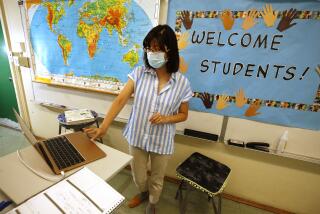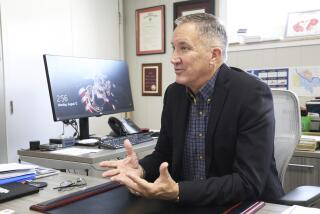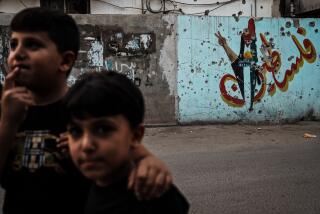Syrian opposition begins rewriting history in textbooks
ANTAKYA, Turkey — In newly printed textbooks at dozens of Syrian refugee schools, a small piece of Middle East geography has been amended.
Seventy-five years ago, Turkey annexed the northern Syrian territory of Hatay against the will of Syria, but maps in Syrian schoolbooks during the lengthy reign of the Assad family have continued to include Hatay inside Syria’s borders. The maps in the new schoolbooks show Hatay in Turkey, one of a number of political changes made by the Syrian opposition group that published the books.
In President Bashar Assad’s Syria, society was built on a fealty to the Baath Party ideology, a one-party system whose influence could be seen at the lowest levels of grade school, where textbooks were tools of propaganda. The new textbooks are an attempt by those in the uprising against Assad to offer a competing narrative and are the beginning of their efforts to rewrite the nation’s history after what they view as more than 40 years of lies and half-truths.
“If we used the same books as the regime then the whole point of the revolution is lost,” said principal Mustafa Shaki, a former Islamic studies teacher and imam of a Damascus mosque. “The revolution came to combat this form of brainwashing that teaches students that [Assad] is the savior and the commander.”
Like the once omnipresent photos of Assad and his father and predecessor, Hafez Assad, which were ripped down in the early days of the uprising, the government story line is gradually dissipating.
“The narrative is going to be written and rewritten many times as the course of this tragedy plays out,” said Amr Al-Azm, a Syrian dissident and professor of Middle East history at Shawnee State University in Ohio. “Right now they are just taking things out, but as time goes on they will start to rewrite the history books once we see who the victor is.”
That version probably will be a reflection of Bashar Assad’s successors, whether they be conciliators, secularists or sectarian-minded purveyors of extreme religious ideology.
The result will be more than just the sort of cosmetic changes and language tweaks in the books distributed in Turkey. The historical reexamination will probably include a new take on the Muslim Brotherhood’s uprising in the 1980s, which was crushed after a government massacre in the city of Hama and helped shape modern Syrian society but was rarely spoken of.
Initially, the Islamic Levant Commission, a group formed by Syrian expatriates that published and distributed the textbooks, planned to provide copies of unaltered books to schools based in refugee camps and towns. But once the first batch was delivered, the group faced a backlash from those who had fled their homes under government bombardment and now regarded such tomes as rank propaganda.
A four-member curriculum committee then went through dozens of books to make changes.
As a result, all photos of Assad and his late father have been removed or blacked out. The Syrian flag has been replaced with the opposition flag. And references to either Assad as “immortal commander” have been deleted.
The Ottoman Empire era is no longer referred to as the Ottoman occupation. The 1970 coup by the elder Assad is no longer called the “Corrective Movement.” The 1973 war with Israel in which Syria failed to retake the Golan Heights has been changed from the “October Liberation War” to just the “October War.” Syria didn’t liberate anything, pointed out Jihad Khiti, education director of the commission.
A nationalism textbook that contains the Assad family’s Baath Party philosophy, was stricken from the secondary school curriculum.
The only reference thus far in textbooks to the current uprising are photos of protests and people who have been killed, including a 13-year-old boy from Dara allegedly tortured to death by government forces, becoming a symbol of resistance in the early months of the opposition movement.
The commission, based in Saudi Arabia, is not the only group reexamining Syria’s school curriculum. Early this year, educators in exile formed the Syrian Education Commission to consolidate efforts to revamp Syria’s education system.
Mohammad Younes Harba, a former physical education teacher in Qusair, is writing a book — part memoir, part history — on the uprising in Homs.
“The goal is to give the Syrian people the right to immortalize their martyrs and correct Syrian history after the forgery of the Baath Party,” he said. “The history of this revolution must be remembered with the pens of the heroes who began it.”
His project is regularly interrupted by his duties as an officer in the Wadi rebel militia and by government shelling of his neighborhood.
“I want future generations, and all others who read the book, to know how we pursued the path of freedom of thought and a dignified life.”
The only refugee elementary school in Antakya is on the outskirts of the city, in a run-down pink and yellow two-story building at the end of a gravel road where shepherds take their flocks.
“From when we are young they have planted the seeds of love [of Assad] against our will. I still have all the pro-regime songs memorized,” principal Dania Bitaar said. “They would feed it to us with everything.”
In Latifa Tarablusia’s fifth-grade class, the daily lesson was about forms of government.
“I told them Syria is a dictatorship,” said the sociology teacher, who is from Latakia. “And I explained to them what a dictatorship is.”
The children offer their own contributions by recounting stories of family members slain.
Fewer than half her students are dressed in the customary blue school uniforms; the remaining uniforms were left behind in Syria when families fled their homes, some expecting to be gone for only a few weeks.
“We like the new books,” said 10-year-old Mariam Najjar, wearing a puffy pink jacket in the unheated classroom. When asked why, she struggled for a few seconds before saying, “They removed the photos of Bashar and that made me happy. He was the one who forced us to come here or else we would be back in Syria.”
“He forced us to emigrate and he killed us,” classmate Jana Kamal said.
“And he destroyed our homes over our heads,” Hasna Zahar added.
Wafa Muhammad, an English teacher from Damascus, said that before the new textbooks were introduced, teachers had students scribble over the Assads’ photos or cut them out.
When the new books were distributed, students were thrilled, said Muhammad, who uses an alias to protect family members still in Damascus.
“This is the fall of the regime by means of overthrowing it in the eyes of the students,” she said.
Yet the commission seems to be engaging in some of its own rewriting.
On Page 163 in the fifth-grade sociology textbook, there had been a photo of Hafez Assad raising the Syrian flag during an October War remembrance. In the new textbook, the photo has been replaced with the iconic World War II image of U.S. Marines raising the American flag during the battle for Iwo Jima.
But rather than the red, white and blue, the soldiers are hoisting the green, white and black Syrian opposition flag.
More to Read
Sign up for Essential California
The most important California stories and recommendations in your inbox every morning.
You may occasionally receive promotional content from the Los Angeles Times.











